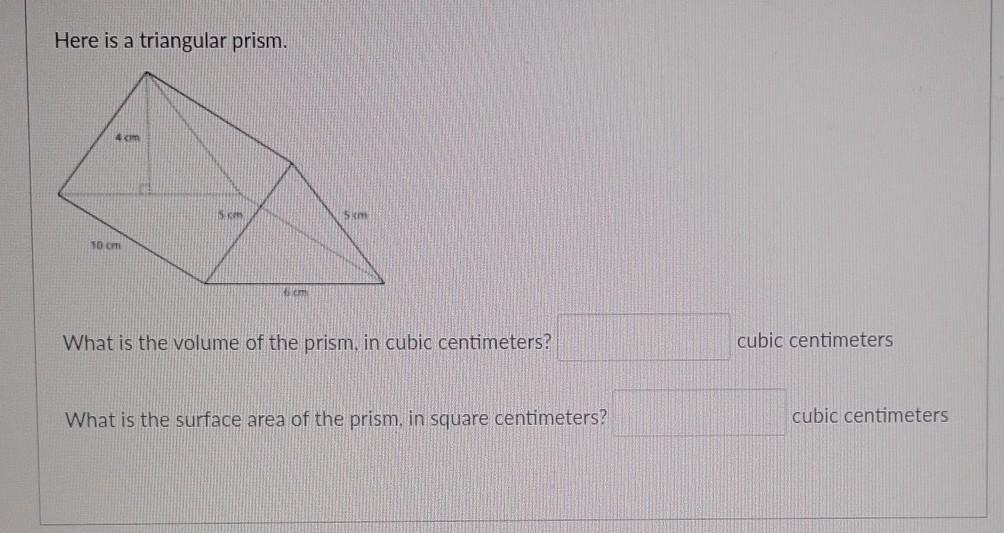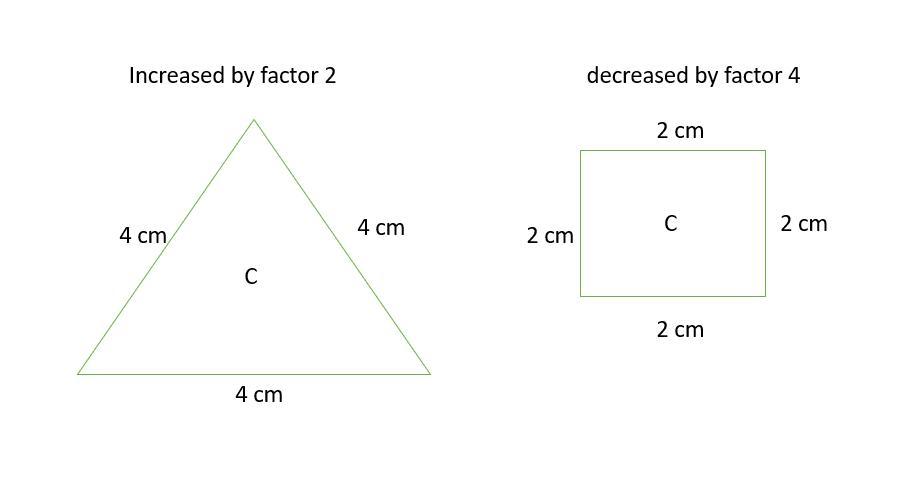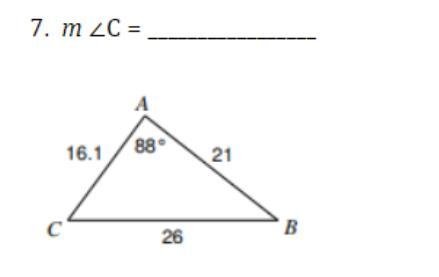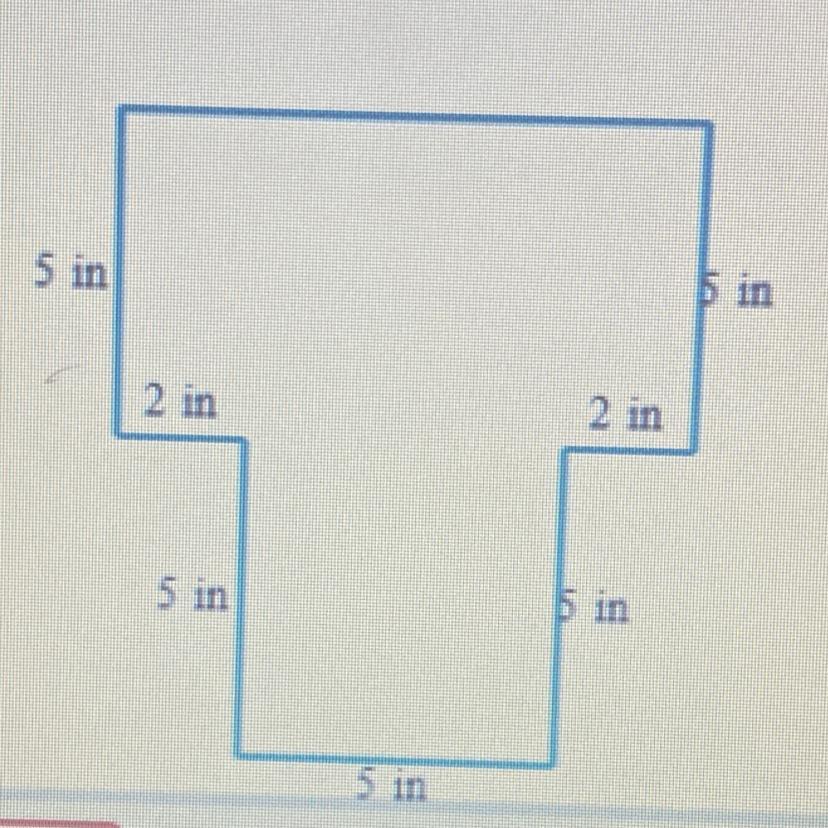Answers
Answer:
70in²Step-by-step explanation:
Find the area of the figure. (Sides meet at right angles.)
1 rettangle on a square
Area Rectangle
(2+2+5)*5=
9*5=
45in²
Area of the Square
5*5=
25in²
sum
45+25=
70in²
Related Questions
a bad contains pennies nickels dimes and quarters they're 50 coins and all of the coins 12% of pennies and 44 dimes there are eight more nickels than pennies how much money does a bag contain
Answers
The total amount of money in the bag is M = $ 2.98
What is an Equation?Equations are mathematical statements with two algebraic expressions flanking the equals (=) sign on either side.
It demonstrates the equality of the relationship between the expressions printed on the left and right sides.
Coefficients, variables, operators, constants, terms, expressions, and the equal to sign are some of the components of an equation. The "=" sign and terms on both sides must always be present when writing an equation.
Given data ,
Let the equation be represented as M
Now , the value of M is
Let the total amount of money in the bag be M
The number of coins in the bag = 50 coins
The number of pennies = 12 % of coins
So , the number of pennies = ( 12/100 ) x 50 = 6 pennies
The number of dimes in the bag = 44 % of the coins
The number of dimes in the bag = ( 44/100 ) x 50 = 22 dimes
The number of nickels = 8 + number of pennies = 8 + 6
The number of nickels = 14 nickels
The remaining number of coins are quarters
On simplifying the equation , we get
So , the number of quarters = 50 - 6 - 22 - 14 = 8 quarters
And , the value of 6 pennies = $ 0.06
The value of 22 dimes = $ 0.22
The value of 14 nickels = $ 0.70
The value of 8 quarters = $ 2.00
Therefore , the total amount in the bag = $ 2.00 + $ 0.70 + $ 0.22 + $ 0.06
The total amount of money in the bag = $ 2.98
Hence , the total money in the bag is $ 2.98
To learn more about equations click :
https://brainly.com/question/19297665
#SPJ9
Nikko needs to get his air-conditioner fixed. The repairman will charge Nikko a flat fee
of $50 plus an additional $20 for each hour he needs to work on it.
Write an equation to represent Nikko's total cost to repair his air-conditioner. Use t for total
cost and h for hours.
Answers
Answer:
$70
Step-by-step explanation:
50+20=70
The required expression is given for the Nikko is t = 50 + 20h.
Given that,
The repairman will charge Nikko a flat fee of $50 plus an additional $20 for each hour he needs to work on it.
The equation is the relationship between variables and represented as y = ax + b is an example of a polynomial equation.
here,
t is the total cost the repairman charged to Nikko,
h is the number of hours,
repair men charges for h hours = $20h
repair men charge a flat fee of $50.
Total charge, t = 50 + 20h
Thus, the required expression given for the Nikko is t = 50 + 20h.
Learn more about equations here:
brainly.com/question/10413253
#SPJ2
In one year, a school uses 13,270 pieces of white paper, 6,570 fewer pieces of blue paper than white paper, and 2,600 fewer pieces of yellow paper than blue paper. How many pieces of paper does the school use in all?
Answers
Answer:
24,070 the school uses in all
Step-by-step explanation:
You subtract 13,270 by 6,570 and you get 6,700 pieces of blue paper. Then, you subtract 6,700 by 2,600 and you get 4,100 pieces of yellow paper. Finally, you add the total of pieces of white, blue, and yellow paper and you get 24,070 for the total.
matt had 4/6 bag of peanuts. He ate a quarter of what was in the bag. How much of a full bag of peanuts did Matt eat?
Answers
Matt ate 1/6 of the bag of peanut
How to calculate the amount of peanut that matt ate?
Matt had 4/6 bag of peanut
He ate a quarter of what was in the bag
The amount of peanut he ate can be calculated as follows
= 4/6 × 1/4
= 4/24
= 1/6
Hence Matt ate 1/6 of the bag of peanut
Read more on quarter here
https://brainly.com/question/29245182
#SPJ1
Which of the following shows the correct solution steps and solution to 2×+ 7 = -11?
Answers
Answer:
x = - 9
Step-by-step explanation:
2x + 7 = - 11 ( subtract 7 from both sides )
2x = - 18 ( divide both sides by 2 )
x = - 9
The answer is:
x = -9
Work/explanation:
The point of equations is to find the variable's value by isolating it step-by-step.
For this equation, the variable is x.
To isolate it, I will perform a few operations.
First, I will subtract 7 from each side:
\(\sf{2x+7=-11}\)
\(\sf{2x=-11-7}\)
\(\sf{2x=-18}\)
Divide each side by 2
\(\sf{x=-9}\)
Hence, x = -9.
\(\rule{350}{4}\)
In a group of 55 examinees taking the 50-item test, Rachel obtained the score of 38. This implies that her score is...
Answers
Answer:
she scored 76 percent in the test
You and your friend are playing "Fire-Water-Sponge." In this game, each of the two players chooses fire, water, or sponge. Both players reveal their choice at the same time, and the winner is determined based on the choices. Fire beats sponge by burning it, sponge beats water by soaking it up, and water beats fire by putting it out. If both players choose the same object, it is a tie. All the possible outcomes of the game are listed below. If we take outcomes 1,5,1,5,1, comma, 5, comma and 888 as a subset of the sample space, which of the statements below describe this subset?
Answers
Consider the following equation. 5x+3y=8 Step 1 of 2 : Determine the missing coordinate in the ordered pair (3,?) so that it will satisfy the given equation.
Answers
Answer: (3, -2.333) or (3, -7/3)
Step-by-step explanation:
We're given an x value (x=3) when looking at the coordinate, so we're trying to find what y is equal to given the equation. We can plug in x=3 into 5x+3y=8 and isolate for y.
\(5(3)+3y=8\\15 + 3y=8\\3y=-7\\y=-\frac{7}{3}\)
Answer:
y= -2 1/3
Step-by-step explanation:
Since you have x, you put x into the equation and work through the problem.
5(3)+3y=8
15+3y=8, then subtract 15 from both sides
3y=(-7), then divide both sides by 3
y=(-7)/3 or (-2 1/3)
Solve for all values of x by factoring.
x2 + 10x + 12 = 2x + 5
Answers
Answer:
Move all terms to the left side and set equal to zero. Then set each factor equal to zero.
x
=
−
1
,
−
7
but its (1,7)
Step-by-step explanation:
)The mean voltage of a battery is 15 and S.D 0.2.Find the probability that four such batteries connected in series will have combined voltage of 60.8 or more volts
Answers
The probability that four batteries connected in series will have a combined voltage of 60.8 or more volts is approximately 0.0228 or 2.28%.
To find the probability that four batteries connected in series will have a combined voltage of 60.8 or more volts, we need to use the concept of the Central Limit Theorem.
In this case, we know that the mean voltage of a single battery is 15 volts and the standard deviation is 0.2 volts. When batteries are connected in series, their voltages add up.
The combined voltage of four batteries connected in series is the sum of their individual voltages. The mean of the combined voltage will be 4 times the mean of a single battery, which is 4 * 15 = 60 volts.
The standard deviation of the combined voltage will be the square root of the sum of the variances of the individual batteries. Since the batteries are connected in series, the variance of the combined voltage will be 4 times the variance of a single battery, which is 4 * (0.2)^2 = 0.16.
Now, we need to calculate the probability that the combined voltage of four batteries is 60.8 or more volts. We can use a standard normal distribution to calculate this probability.
First, we need to standardize the value of 60.8 using the formula:
Z = (X - μ) / σ
Where X is the value we want to standardize, μ is the mean, and σ is the standard deviation.
In this case, the standardized value is:
Z = (60.8 - 60) / sqrt(0.16)
Z = 0.8 / 0.4
Z = 2
Next, we can use a standard normal distribution table or calculator to find the probability associated with a Z-score of 2. The probability of obtaining a Z-score of 2 or more is approximately 0.0228.
Therefore, the probability that four batteries connected in series will have a combined voltage of 60.8 or more volts is approximately 0.0228 or 2.28%.
Learn more about probability here:
https://brainly.com/question/23417919
#SPJ8
-140=-4 (8n - 57)
What’s the answer I keep getting a decimal
Answers
Answer: n = 11.5
Step-by-step explanation:-140=-32n +228
-368=-32n
the photo attached has the work done out and i got a decimal as well
Graph the arithmetic sequence.
$4,\ 12,\ 20,\ 28,\ ...$
Keyboard Instructions
Initial graph state
The horizontal axis goes from -0.8 to 6 with ticks spaced every 1 unit(s).
The vertical axis goes from -2 to 30 with ticks spaced every 4 unit(s).
Answers
The graph of the arithmetic sequence is added as an attachment
How to graph the arithmetic sequence?From the question, we have the following parameters that can be used in our computation:
Sequence: 4, 12, 20, 28....
The above sequence is an arithmetic sequence with the following parameters
First term, a = 4
Common difference, d = 8
So, the x-th term is
f(x) = a + (x - 1) * d
Substitute the known values in the above equation, so, we have the following representation
f(x) = 4 + (x - 1) * 8
This gives
f(x) = 8x - 4
So, the equation to plot is f(x) = 8x - 4
See attachment for the graph
Read more about sequence at
https://brainly.com/question/6561461
#SPJ1

HELP ASAP
Compare the volume of these two shapes, given the radii are the same.

Answers
Answer:
The left cylinder has greater than the right cylinder.
Step-by-step explanation:
Volume of a cylinder is the area of a base times the height.
As the radii are identical, the area of each base is πr²
As the left cylinder has greater height, it also has greater volume.
How many boogers does Karissa the ogre have in her left nostril? statistcal or not
Answers
Answer:
non statistical
Step-by-step explanation:
khan acadamy
Write an integer to represent the following situation: A boat is sitting at sea level.
Help plzzzzz
Answers
Answer:
0 because 0 is sea level, anything below is negative and anything above is positive. hope this is helpful
Step-by-step explanation:
Answer:
Its 0 :)
Step-by-step explanation:
Type < or > to make this statement true -a___-b
Answers
The comparisons that are true are 11. -5 < 0 12. 9 > -8 14. 55 > -75 15. -32 < -24 16. 89 > 73 17. -58 < -51 19. 17 < 23 20. 18 > -36 and that is not true are 13. -7 = -7 (not true) 18. -32 > 4 (not true)
To make each statement true, write < or >. We need to compare two values for each statement to determine whether it is true or false.
To indicate that the first value is less than the second value, write <.
Alternatively, to indicate that the first value is greater than the second value, write >.
Below are the comparisons: 11. -5 < 0 12. 9 > -8 13. -7 > -7 14. 55 > -75 15. -32 < -24 16. 89 > 73 17. -58 < -51 18. -32 > 4 19. 17 > 23 20. 18 > -36
To determine the direction of inequality, we need to compare the values.
We used inequality signs such as > (greater than) or < (less than) to indicate which value is larger or smaller than the other.
For more questions on comparisons
https://brainly.com/question/30097421
#SPJ8
The correct question would be as
Write > or < to make each statement true.
11. -5 0
12. 9 -8
13. -7 7
14. 55 -75
15. -32 -24
16. 89 73
17. -58 -51
18. -32 4
19. 17 23
20. 18 -36
Someone please help me, I can't figure this out. I already asked this but I got a file. Please no files, I'm begging, I just want my math answers. Thank you,
(Look in image for question)
(Measurements are 4cm, 10cm, 5cm, 6cm, and 5cm).

Answers
Answer:
I believe the volume is 120 and the surface area is 124
Step-by-step explanation:
A jar of peanut butter contains 50 tablespoons of peanut butter.
How many sandwiches can you make from the jar of peanut butter, assuming you have plenty of bread and jelly?
A. 25 sandwiches
B. 9 sandwiches
C. 10 sandwiches
D. 50 sandwiches

Answers
Answer:
the correct answer is A. 25 sandwiches.
Step-by-step explanation:
Assuming you have plenty of bread and jelly, you can make 25 sandwiches from the jar of peanut butter.
Each sandwich typically requires 2 tablespoons of peanut butter, one slice of bread with peanut butter and one slice of bread with jelly.
So, if you have 50 tablespoons of peanut butter, you can make 25 sandwiches with it, because 50 / 2 = 25.
Therefore, the correct answer is A. 25 sandwiches.
Answer: 25
Step-by-step explanation:
We have 50 tablespoons of peanut butter and we know that it requires 2 tablespoons to make a single sandwich. In order to find how many sandwiches we can make with our 50 tablespoons, we would have to do 50 divided by 2.
2+2...=50
i
dont
get
this
help
rn

Answers
Answer:
6 first box. 12 second box. 21 third box. 10 fourth box. 4 fifth box.
Step-by-step explanation:
Look for common denominaters, that will show you what to multiply the equation by to get rid of fractions.
Find sin 2 x, cos 2 x , and } tan 2 x if tan x=-3 and x terminates in quadrant IV.
sin 2 x= ?
cos 2 x= ?
tan 2 x=?

Answers
The values of sin 2x, cos 2x , and tan 2x are -3/5, -4/5 and 3/4 respectively
How to find sin2x, cos2x and tan2x?Trigonometry is a branch of mathematics dealing with the relationship between the ratios of the sides of a right-angled triangle with its angles.
Given that: tan x = -3 and x terminates in quadrant IV
(Check the attached image for the drawing)
tan x = -3/1 (opposite/adjacent)
hypotenuse = √((1)²+(-3)²) = √10
sin x = -3/√10 (opposite/hypotenuse)
cos x = 1/√10 (adjacent/hypotenuse)
Using trigonometric identity:
sin 2x = 2 sin x cos x
sin 2x = 2 × (-3/√10) × (1/√10) = -6/10 = -3/5
cos 2x = 2cos²x - 1
cos 2x = 2×(1/√10)² - 1 = 2/10 - 1 = -4/5
tan 2x = sin 2x/cos 2x
tan 2x = (-3/5)/(-4/5) = 3/4
Learn more about Trigonometry on:
brainly.com/question/29529966
#SPJ1

Find the slope
1) Through: (4,-3) and (-2,5)
2) Through: (2,-1) and (0,-4)
Answers
Answer:
1) \(\frac{4}{-3}\)
2) \(\frac{3}{2}\)
Step-by-step explanation:
To find the slope, we can use the slope formula:
\(\frac{y2 - y1}{x2 - x1}\)
1. Through (4,-3) and (-2,5):
Slope = \(\frac{5 - (-3)}{-2 - 4}\)
Slope = \(\frac{8}{-6}\)
Simplified to: \(\frac{4}{-3}\)
2. Through (2, -1) and (0, -4)
Slope = \(\frac{-4 - (-1)}{0 - 2}\)
Slope = \(\frac{-3}{-2}\)
Slope = \(\frac{-3}{-2} \cdot \frac{-1}{-1} = \frac{3}{2}\)
Meaning that the slope of 1) is \(\frac{4}{-3}\) and the slope of 2) is \(\frac{3}{2}\).
Hope this helps!
I need help with this please

Answers
please help me in this question please

Answers
Step-by-step explanation:
here is your answer, this is how you do it


Answer:
\(\boxed{\bf G. \: x = {25}^{o}} \)
\(\boxed{\bf H. \: x = {20}^{o} }\)
Step-by-step explanation:
In the given figure, the linear pairs are supplementary angles, meaning they should add up to 180°.
G)
\(\bf 2x + 34 + x + 71 = 18 {0}^{o} \)\(\bf 3x + 105 = 18 {0}^{o} \)\(\bf 3x = 180 - 105\)\(3x = 75\)\(\boxed{\bf x = {25}^{o} }\)H)
\(\bf 2x + 4x + 3x = {180}^{o} \)\(\bf 9x = 180\)\(\boxed{\bf x = {20}^{o} }\)«••••••••••••»«•••••••••••••»
100 Points! Geometry question. Photo attached. Please show as much work as possible. Thank you!

Answers
The scaled triangle will be larger than the initial size by a factor 2.
The scaled square will be smaller than the initial side by a factor 4
What is dilation?Dilation refers to a transformation that changes the size of a geometric figure without altering its shape.
Dilation involves scaling an object by a certain factor, that might result in enlarging or reducing its dimensions uniformly in all directions.
Based on the given diagram, the new length and size of the object is calculated as follows;
For the triangle, (measure the length with ruler)
new lengths = 2 times the original lengthoriginal length = 2 cm, new length = 4 cmthe new size of the triangle will increase by a factor 2For the square; (measure the length with ruler)
new lengths = 0.25 times the original lengthoriginal length = 4 cm, new length = 2 cmthe new size of the square will decrease by a factor 4Learn more about dilation here: https://brainly.com/question/20482938
#SPJ1

Find the area of the triangle with a pase or 30 cm and a neignt of 28 cm. a 425 sq. cm b 540 sq. cm c 440 sq. cm d 420 sq. cm
Answers
The base of triangle is b = 30 cm.
The height of triangle is h = 28 cm.
Determine the area of the triangle.
\(\begin{gathered} A=\frac{1}{2}\cdot b\cdot h \\ =\frac{1}{2}\cdot30\cdot28 \\ =15\cdot28 \\ =420 \end{gathered}\)Thus, area of triangle is 420 sq. cm
Help really fast! C=?

Answers
Answer:
Your answer will be 70 degrees
Step-by-step explanation:
Let sinθ= 2√2/5 and π/2 < θ < π Part A: Determine the exact value of cos 2θ. Part B: Determine the exact value of sin (θ/2)
Answers
Answer:
Part A: To determine the exact value of cos 2θ, we can use the double-angle identity for cosine:
cos 2θ = 2 cos^2 θ - 1
We already know sin θ, so we can use the Pythagorean identity to find cos θ:
cos^2 θ = 1 - sin^2 θ
cos^2 θ = 1 - (2√2/5)^2
cos^2 θ = 1 - 8/25
cos^2 θ = 17/25
cos θ = ± √(17/25)
cos θ = ± (1/5) √17
Since θ is in the third quadrant (π/2 < θ < π), cos θ is negative, so we take the negative root:
cos θ = -(1/5) √17
Substituting into the double-angle identity:
cos 2θ = 2 cos^2 θ - 1
cos 2θ = 2 [-(1/5) √17]^2 - 1
cos 2θ = 2 (1/25) (17) - 1
cos 2θ = 34/25 - 1
cos 2θ = 9/25
Therefore, the exact value of cos 2θ is 9/25.
Part B: To determine the exact value of sin (θ/2), we can use the half-angle identity for sine:
sin (θ/2) = ± √[(1 - cos θ)/2]
We already know cos θ, so we can substitute it in:
cos θ = -(1/5) √17
sin (θ/2) = ± √[(1 - cos θ)/2]
sin (θ/2) = ± √[(1 - (-1/5) √17)/2]
sin (θ/2) = ± √[(5 + √17)/10]
sin (θ/2) = ± (1/2) √(5 + √17)
Since θ is in the third quadrant (π/2 < θ < π), sin θ is negative, so we take the negative root:
sin (θ/2) = -(1/2) √(5 + √17)
Therefore, the exact value of sin (θ/2) is -(1/2) √(5 + √17).
The exact values of the sine and cosine given are -(1/2) √(5 + √17) and 9/25.
What is the sine and the cosine of an angle?The sine of an angle in a right triangle is the ratio of the hypotenuse to the side opposite the angle.
The cosine of an angle in a right triangle is the ratio of the hypotenuse to the side adjacent the angle.
Part A: To determine the exact value of cos 2θ, we can use the double-angle identity for cosine:
cos 2θ = 2 cos² θ - 1
Using the Pythagorean identity to find cos θ:
cos² θ = 1 - sin² θ
cos² θ = 1 - (2√2/5)²
cos² θ = 1 - 8/25
cos² θ = 17/25
cos θ = ± √(17/25)
cos θ = ± (1/5) √17
Since θ is in the third quadrant (π/2 < θ < π), cos θ is negative, so we take the negative root:
cos θ = -(1/5) √17
Substituting into the double-angle identity:
cos 2θ = 2 cos² θ - 1
cos 2θ = 2 [-(1/5) √17]² - 1
cos 2θ = 2 (1/25) (17) - 1
cos 2θ = 34/25 - 1
cos 2θ = 9/25
Therefore, the exact value of cos 2θ is 9/25.
Part B: To determine the exact value of sin (θ/2), we can use the half-angle identity for sine:
sin (θ/2) = ± √[(1 - cos θ)/2]
We already know cos θ, so we can substitute it in:
cos θ = -(1/5) √17
sin (θ/2) = ± √[(1 - cos θ)/2]
sin (θ/2) = ± √[(1 - (-1/5) √17)/2]
sin (θ/2) = ± √[(5 + √17)/10]
sin (θ/2) = ± (1/2) √(5 + √17)
Since θ is in the third quadrant (π/2 < θ < π), sin θ is negative, so we take the negative root:
sin (θ/2) = -(1/2) √(5 + √17)
Therefore, the exact value of sin (θ/2) is -(1/2) √(5 + √17).
Hence, the exact values of the sine and cosine given are -(1/2) √(5 + √17) and 9/25.
Learn more about sine and the cosine of an angle, click;
https://brainly.com/question/3827723
#SPJ2
Help :') ................................


Answers
Answer:
1. 90
2. 120
3. 30
4. 60
Step-by-step explanation:
Hope it helps
How do I find the largest five-digit number which, when divided by 9, 12, 24 and 45, leaves remainders of 3, 6, 18, and 39, respectivly?
Answers
The average largest five-digit number which leaves remainders of 3, 6, 18 and 39 when divided by 9, 12, 24 and 45 respectively is 99741. This can be found by starting at the highest possible number (99999) and subtracting until the remainders of each division are obtained.
To find the largest five-digit number which leaves remainders of 3, 6, 18 and 39 when divided by 9, 12, 24 and 45 respectively, begin by setting the highest possible number (99999). Then, subtract until the remainders of each division become 3, 6, 18 and 39 respectively. This can be done by subtracting 3 from the initial number and then 6, 18, and 39 in order to get the correct remainders. This process can be repeated until the number reaches 99741, which is the largest five-digit number that leaves the given remainders. This number can also be found by using the formula (9x + 3)(12x + 6)(24x + 18)(45x + 39). By plugging in x = 999, the answer of 99741 is obtained.
Learn more about average here
https://brainly.com/question/24057012
#SPJ4
The area of a square lawn is 100 square yards. How long is each side of the lawn?
Answers
Answer:
25
Step-by-step explanation:
a square has 4 sides.
100/4=25
